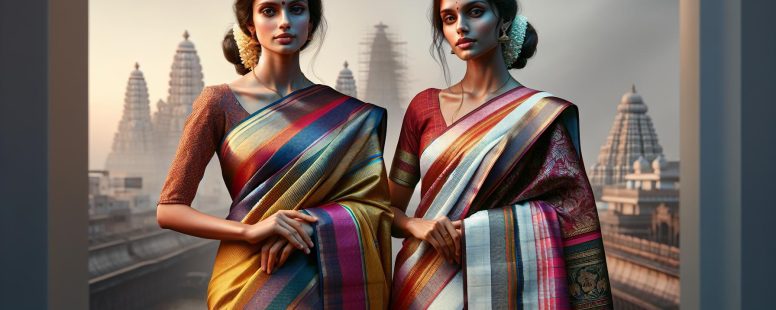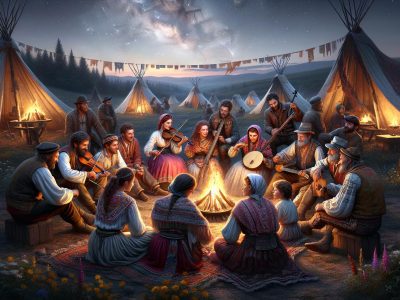Unraveling the Differences: Iyer vs. Iyengar Madisar into Modern Times
Ever been intrigued by the rich world of Indian culture? You’re not alone. The nuances of traditions and customs can be fascinating, and today, we’re diving into one such captivating aspect. We’re exploring the subtle differences between the Iyer and Iyengar Madisar, two traditional saree drapes from the South Indian Brahmin community.
Is it just a matter of regional variation or is there more to the story? And how can you distinguish between the two styles? If these questions have piqued your interest, you’re in the right place. This article will unravel these differences, taking you on a journey through the cultural labyrinth of South India. So, let’s investigate into this interesting topic together and uncover the secrets of the Madisar.
Understanding Madisar: The Traditional Tamil Attire
Historical Significance of Madisar
The Madisar carries substantial historical weight, originating centuries ago as a sari drape in the Tamil Brahmin community. Its evolution tracks alongside the societal development of the community over time. It represented an important rite of passage for women, signifying their transition into adulthood and marriage, a practice still observed today. In earlier times, the significance of Madisar was such that not wearing it indicated widowhood or rejection by society. Today, it represents a monument of cultural history, a proud testament to the carried-forward tradition on special occasions, and a vivid counterpoint to the unspoken narratives embedded in the warp and weft of history.
The Role of Madisar in Tamil Culture
Cut from the same cultural fabric, Madisar’s role in Tamil culture is emblematic. It constitutes an important aspect of Tamil Brahmin traditions. Predominantly worn during sacred rituals and ceremonies, it acts as a lyrical symbol of the heritage that suffuses festivals like Pongal, Tamil New Year, and weddings. The wearers of the Madisar, both Iyer and Iyengar, follow distinct draping styles reflective of their community’s customs, underscoring their unique identities while still celebrating the shared Tamil Brahmin culture. Even though modernization and western influences, the Madisar retains its pivotal position in this vibrant culture, a symbol of tradition and continuity in changing times.
In the next sections, we’ll investigate deeper into the distinctive characteristics of Madisar as worn by the Iyer and Iyengar communities, respectively. Watch for the nuanced differences in style and tradition that accentuate their unique identity within the Tamil Brahmin community.
The Iyer Madisar: Features and Styles
Delving further into the intriguing differences between Iyer and Iyengar Madisars, our focus now shifts to an in-depth examination of the features and styles of the former. The Iyer Madisar, a core element of the Tamil Brahmin tradition, boasts of unique fabric choices, color palettes, and draping methods. The below discussion elucidates these variants, enriching our understanding of the Iyer iteration of Madisar.
Fabric and Color Choices
When choosing a Madisar, Iyers often lean towards cotton and silk fabrics. Favoring natural fibers, they find that these materials not just enhance comfort but lend an ethnic elegance to the drape. Colors play a pivotal role too. Even though black and white hues facing a general taboo in auspicious occasions, a range of vibrant color combinations emerge in the Iyer Madisar wardrobe. From fiery reds symbolizing power and passion to serene greens echoing prosperity, the color palette displays an intricate balance of symbolic undertones and aesthetic allure.
Draping Techniques of Iyer Madisar
The draping style of an Iyer Madisar exhibits an intricate dance of precision and elegance. It takes the form of a nine-yard wonder, winding its way around the body with calculated grace. Unlike regular six-yard sarees, this special drape follows a unique pattern that extends from the waist, passes underneath the right shoulder, and then returns across the left shoulder in a distinctive loop. To drape it, you start by tucking one end into the waistband of your petticoat, with about one yard left hanging in front, leaving the lengthy piece behind. This elaborate process culminates in a distinctive figure-flattering silhouette, its draped layers serving as both an emblem of cultural heritage and a robust code of modesty.
The Iyengar Madisar: Distinctive Elements
Unique Aspects of Iyengar Madisar
Unlike the Iyer Madisar, the Iyengar Madisar sports distinct characteristics, tailored to the customs of the Iyengar community. This traditional nine-yard saree tends to favor darker colors such as maroon, green, or blue. Another defining characteristic lies in the pleats; they’re uniquely placed facing right, differing from the left-facing arrangement in the Iyer community.
Fabrics play a paramount role, too. They favor higher quality pure silk fabrics sourced typically from Kanchipuram, a region renowned for its silk. The Iyengar Madisar is also marked by the use of border colors, often representative of the individual’s marital status. For instance, a red-colored border suggests a married lady, whereas a green one hints at a maiden.
Ritual Significance in Iyengar Community
The Iyengar Madisar’s cultural importance runs deep. It marks significant stages in a woman’s life, primarily her transition from maidenhood to womanhood – a rite of passage during her wedding ceremony. After adorning the Madisar, the woman enters her new life as a married woman, signifying her readiness to take on new roles and responsibilities.
But, the relevance of Madisar doesn’t stop at weddings. It is also featured extensively in various religious ceremonies, celebrations, and festivals of the Iyengar community. The Madisar’s choice for these occasions signifies respect and reverence for the tradition, a testament to its enduring cultural relevance and importance.
Distinguishing the Iyengar and Iyer Madisar elucidates the intricate nuances of these similar yet distinct cultural artifacts, unraveling more than meets the eye, revealing their deep-rooted symbolism in South India’s socio-cultural world.
Key Differences Between Iyer and Iyengar Madisar
Variations in Draping Styles
While both Iyer and Iyengar Madisars use the same 9-yard saree, draperies distinguish them. Iyer Madisar, for instance, primarily features a back-pleat tying method. Counting from one end of the saree, about 6 yards makes up the skirt part while the remaining length forms the pallu (called velai in Tamil), slanting from the left over the right shoulder.
Contrarily, Iyengar Madisar is identified by the front-tying pleats. Divide the saree into two unequal parts, a more extended section for the skirt and shorter for the pallu. The pallu, hanging downward from your right shoulder, is typically longer in Iyengar style, reaching till feet.
Symbolic Meaning of Colors and Patterns
Beyond draping, the colors and patterns also contribute to differentiating Iyer and Iyengar Madisar. In Iyer style, more neutral hues like beige, off-white, or light pink are predominantly used. Striped patterns, known as ‘Mayilkan’ with ‘kodi’ or ‘rudraksha’ design, are often seen in Iyer’s Madisar.
But, Iyengar Madisar has an affinity for darker shades. Rich reds, vibrant greens, or intense blues are usual in this style. They also flaunt ‘annapakshi’ or ‘yanai’ designs, with the border commonly featuring temple tower motifs, termed ‘gopuram’.
Remember, even though these differences, both types of Madisar reflect unique cultural identities while paying homage to traditions passed down generations. The nuances in their styles, color preferences, and design significances celebrate diversity within unity.
The Evolution of Madisar in Modern Times
As times shift, traditions too mold themselves to keep pace, yet manage to remain wrapped in the essence of their original identity. Such is the story of Madisar, a traditional South Indian Brahmin saree, distinctively worn by the Iyer and Iyengar communities. The voyage of Madisar from its conventional frames to the contours of changing times, while holding true to its roots, is illustrated under specific sub-themes below.
The Influence of Generation and Fashion
Evolving generations carry forward cultural imprints, tweaking them with personal tastes and emerging trends. This flux influences the Madisar significantly, bringing in modifications that are visible in its material, design, and even its draping style.
For instance, while pure silk remains the favorite fabric choice, a glance into the quintescence of modern wardrobes reveal Madisars constructed out of fabrics like cotton, artificial silk, or blended materials. Modern-day Iyer and Iyengar women gravitate towards these fabrics for their comfort, affordability, and ease of maintenance.
Similarly, observing trends, the palette of Madisar expands from traditional solid colors, such as maroon for Iyengar and rust red for Iyer, to include vibrant shades and intricate patterns. Also, these alterations do not dilute but enrich the distinct Iyer and Iyengar Madisar identities with a sprinkle of contemporary flair.
Preserving Tradition: Madisar in Contemporary Ceremonies
Even though the surge of modernization, traditional ceremonies still draw Madisar in its original form, representing its profound connection to the roots. It’s during wedding ceremonies, ritualistic events, and festivals that the Iyer and Iyengar Madisar styles find their purest expression.
To this day, it’s a common sight to observe the 9-yard long, right-side pleated Iyengar Madisar adding grandeur to religious ceremonies, its grace unabated. Similarly, the Iyer Madisar, with its single knot tied at the back, continues to gleam in the nuptial settings, representing a bride’s step into womanhood.
So, even though the influences of modern trends and tastes, the traditional Madisar morphs yet retains its essence, a symphony of the past and present, blending harmony into the folds of an ever-evolving culture. The beauty of Madisar lies in its seamless amalgamation of tradition and transformation, making it an enduring icon of South Indian Brahmin heritage.
Conclusion
You’ve journeyed through the intriguing world of Iyer and Iyengar Madisar, discovering the nuances that make each unique. You’ve seen how these traditional sarees, steeped in history and culture, have evolved with time while maintaining their symbolic significance. The Iyer and Iyengar Madisar aren’t just pieces of fabric, they’re embodiments of South Indian Brahmin heritage. Their color palettes, fabric choices, and draping styles tell a story of tradition and transformation. As you’ve learned, these sarees continue to be a key part of wedding rituals and festivals, blending seamlessly with modern influences. So, whether it’s the rich hues of an Iyengar Madisar or the distinct draping style of an Iyer Madisar, each holds a special place in the world of South Indian culture. This exploration truly underscores the beauty of the Madisar – an enduring symbol of heritage and evolution.
- Understanding the Difference Between Annulled and Divorced: Key Legal and Emotional Insights - October 30, 2025
- Ibuprofen vs. Aspirin: A Comprehensive Comparison - October 30, 2025
- The Difference Between Kosher Salt and Other Salts: Texture, Flavor, and Best Uses Explained - October 30, 2025







